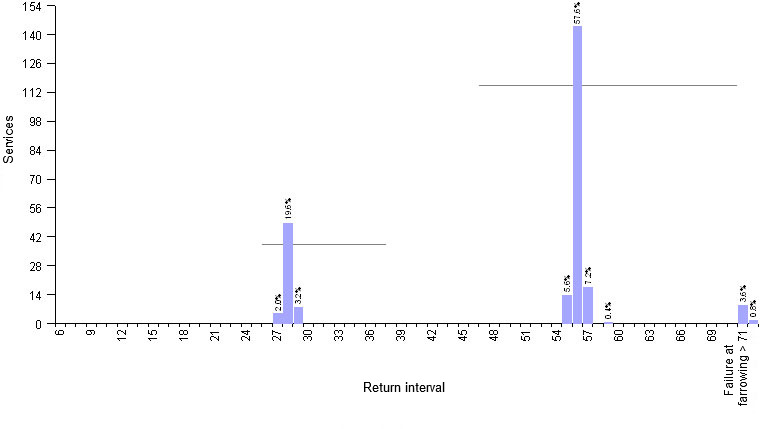It is very common, in today's swine industry, to use more-than-1-week batch farrowing systems in small farms (up to 500 productive sows). The advantages on those batch farrowing systems include: better organization of farm tasks, as well as both health and logistic advantages due to the production of larger weaning batches, farther apart in time and with a bigger age difference amongst them. The most common management in Spain is 3-week batch farrowing, with an average lactation length of about 28 days, but there are several different types of batch farrowing systems.
This article discusses 4-week batch farrowing (4WBF), very common in small farms (250 sows) in some other countries, including France. Analysis will be based on a comparison with 3-week batch farrowing (3WBF)

Lactation length
While 3WBF requires a lactation length of 28 days, 4WBF forces a length of 21 days. Obviously, it is an important change, which advantages and disadvantages have to be assessed before making a decision.
Batch size
4 Week BF results in 5 batches of sows, 2 batches less than 3WBF systems, therefore batch size is bigger. As an example, a 250-sow farm would have about 50 farrowings per batch in 4WBF, and about 36 in 3WBF. Age difference between weaner batches is 4 weeks for 4WBF and three weeks for 3WBF. Bigger batch size and wider age difference between batches of 4WBF will become an advantage in logistics and health terms. As an example, in farrow to finish farms bigger batches would mean sharing fewer slaughter trucks, therefore significantly improving areas such as biosecurity.
Task planning
The Table below shows weekly planning of main tasks (mating, M, farrowing, F, and weaning, W) for both types of management.
Table 1.- Weekly task planning.
| Week | |||||||||
| 1 | 2 | 3 | 4 | 5 | 6 | 7 | 8 | 9 | |
| 3WBF | M | F | W | M | F | W | M | F | W |
| 4WBF | M - F | W | M - F | W | M - F | ||||
Tasks are more widely distributed in 3WBF. However, what appears to be a disadvantage in 4WBF can be an advantage: having 2 weeks free of the most important tasks (matings, farrowings and weaning), can help to better organize other activities such as agricultural tasks, holidays, training, maintenance work, general cleaning, etc...
Optimization of facilities

If we only consider sow accommodation, without considering weaner or finisher facilities, a significant advantage of 4WBF is the optimum use of farrowing crates: since farrowings take place every 4 weeks, and lactation length is 3 weeks, it only requires farrowing crates to fit one farrowing batch. Following the example above, a 250-sow farm would need 50-55 farrowing crates for 4WBF, instead of 75-80 crates needed if working with 3 week BF. On the other hand, 4WBF would require more dry sow accommodation, since larger batches are weaned, (although we must remember that farrowing crates are always more expensive than dry sow accommodation)
Table 2.- Farrowing room occupancy weekly planner, E: entry; F: Farrowing: L: lactation; W: Weaning
| week | ||||||||
| 3WBF | 1 | 2 | 3 | 4 | 5 | 6 | 7 | 8 |
| room 1 | E-F | L | L | L | W | E - F | L | L |
| room 2 | L | W | E - F | L | L | L | W | E - F |
| week | ||||||||
| 4WBF | 1 | 2 | 3 | 4 | 5 | 6 | 7 | 8 |
| room 1 | E - F | L | L | W | E - F | L | L | W |
Maintaining bacth size
On the other hand, keeping batch integrity is the main drawback of 4WBF, since most returns are regular and would, therefore, fall out of batch. This fact forces the farmer not to service those returns when they are found to be on heat. They must either synchronise them by using hormones and mating them at next batch (after 56 days) or skip several oestrus until their heat fits with a batch ( 84 day approx). This involves an important increase of non-productive days and extra cost due to hormone use. Obviously, when gestation results are better, with fewer reproductive losses, these negative effects will be smaller.

Graphic 1.- Example of 4WBF farm: planning of return sow mating by use of hormones. Average return interval 51,6 days
Use of nurse sows
Strict implementation of batch farrowing makes it difficult to use nurse sows, especially when working with 4WBF, since most piglets present at the farrowing house are nearly the same age. A strategy that would allow the use of nurse sows is to have a small farrowing house to place sows mated out of batch that could be used as nurse sows. This facility would also allow mating of some females that fall out of batch, although it could lead to negative effects (not strict separation by age of weaning batches, more heterogeneous batches).
As a conclusion, 4-week batch farrowing is a feasible option for small farms to be considered, although there are differences when compared to more traditional 3-week batch farrowing systems that should be assessed in every situation.




